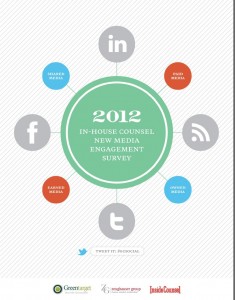Thinking about the best way to structure that Alternative Fee Agreement your client is requesting? Well, it may take some time up front and some serious understanding of the benefits for both client and law firm to strike the right balance. And, as in most things alternative, AFAs are situational, but when done properly can be a win-win for everyone.
For anyone new to the discussion, the best place to start may be to understand why the topic of AFAs has escalated in the past year or so. While the “economic downturn, everything is changing” scenario is a good start, according to Will Auther, a partner at Bowman and Brooke, sophisticated buyers of legal services have ALWAYS relied on fee ‘arrangements’ as opposed to the billable hour. It’s just lately that the rank and file client has challenged the commonly accepted billable hour.
When I spoke with Will last week, he shared with me some of the key issues that his panel will be addressing at the June 9-10 Raindance Conference presented by the Legal Sales and Services Association and West Legal Education. Joining Will on the panel are David Susler, Associate General Counsel at National Material, L.P., Anita J. Wilson, VP and Chief Employment Counsel for TreeHouse Foods, Inc., Patrick J. Lamb, Founding Partner of Valorem Law Group.
If you’re short on time, I’ll tell you the punch line—your missing the boat if you think they can’t be used for almost every type of matter your law firm handles. If you want the whole story you’ll have to attend RainDance 2010. It’s sure to be enlightening. Meanwhile, here’s the sweet low down.
[VMO NOTE: This post reflects the notes I took during our conversation and are not verbatim. I have used the “interview” format to make for easier reading.]
VMO: Why are we talking about Alternative Fee Agreements? What’s the story?
WILL: Our firm has been using [alternative] fee agreements for as long as I can remember. Depending on whom you talk to, hourly billing didn’t become vogue until sometime in the 60’s, maybe 70’s. Before the billable hour it would work like this; a client came to your law firm with a legal need, a lawyer would deliver services, write out a bill for services based on the value he or she believed was delivered—rendered X DOLLARS—and the client would pay it. End of story.
As legal services became commoditized in the eyes of, for example, insurance companies who believed the amount of time spent on such and such type case was fairly predictable, there was a move to dictate what an hour of time was worth to them, thus, the billable hour. I don’t think you’ll find many lawyers had that mindset early on; it was driven by an industry clients that wanted to quantify the work. [See also new reader comment below for more insight on how the billable hour came about]
The billable hour then led to what we now know as the common business model for larger law firms; LEVERAGE. Leveraged pyramids didn’t exist in the old law firm business model, only value for services rendered which is essentially a Fee Agreement.
VMO: As they say, what’s old becomes new again. Why is the model now swinging back to Fee Agreements?
WILL: For the past twenty years or so law firms incrementally raised their hourly billing rates, annually. Clients were seeing their rates rise but they continued to receive the same value and same service. (VMO: obviously not a sustainable proposition and that’s why we’re talking about Alternate Fee Agreements today!) Even before the economic down turn general counsel began trying to figure out how to fix it. One big factor in the current discussions has been the Association of Corporate Counsel’s Value Challenge. The ACC Value Challenge has elevated the discussion to a different level. Sectors that had not previously been thinking about what sophisticated users of legal services were doing for a long time are now reaching into the business models of every firm. AFAs have become THE hot topic in past year. That’s why we’re hearing so much about it. Small, medium, large, sophisticated and non-sophisticated purchasers of legal services are waking up the discussion. If you think about it, law firms today are primarily comprised of attorneys and in-house counsel who literally grew up with the billable hour. So, this is a big departure for many and one that needs careful attention to do them well.
VMO: The Alternative Fee Agreements I’m seeing today are pretty sophisticated, more than an old-time agreement of X for services rendered. What’s working?
WILL: Yes, that’s right. There are many ways to skin a cat and it pretty much comes down to how you want to share the risk with your client. For example, you can approach an Alternative Fee Agreement with fixed fees, phased fees, milestone fees, bonus fees, volume arrangements, contingency fees, or disaggregation of services, i.e. bill or price on a commodity basis.
No matter what the approach one thing is true of all; an Alternative Fee Agreement is a move away from the billable hour. Discounts and blended rates are NOT an AFA, because they do not take the emphasis off the billable hour. Though some will still debate this, the fact is, discounts and blended rates do not drive down cost for the client nor improve the profit line for the law firm, two elemental reasons for instituting Alternative Fee Arrangements. This will be a topic that the panel will be going into with more detail.
VMO: What’s in it for the client and what’s in it for the law firm? Why does it work?
WILL: There is great benefit for the client. AFAs will drive down costs over a period of time and they offer predictability. Sophisticated clients know their metrics – when and how much they’re going to be sued – it’s typically a line item on an annual budget.
For law firms, using tools and processes to deliver value to the client while reducing their own internal cost can increase their profit margin over time. When done right and well, it’s a win-win situation. For example, law firms might use early case evaluations to help the client make a decision whether the case should be settled early on.
Further, depending on the structure of the agreement an AFA can be an annuity for the firm without the cost of administrative oversight, collections and such. In fact, for both client and law firm there are significant efficiencies. The law firm can reduce payment delays and both parties eliminate time consuming conflicts over billing issues.
Mutual trust is a cornerstone of alternative fees. So, although there may be a substantial investment of time and resources at the on-set in developing an acceptable framework, in the long run it is time well spent for the law firm and the client. Arrangements built on mutual trust and willingness to share the risk typically lead to a long-term relationships.
VMO: Who is typically involved in pricing this modern version of the Alternative Fee Agreement?
WILL: It probably goes without saying that the Alternative Fee Agreement is a business transaction that is separate and apart from the legal transaction. In its simplest form it is a business proposal for the client and the law firm to work out and “agree” upon.
Alternative Fee Agreements are essentially the evolution of what it takes to deliver value to clients. Sophisticated clients typically know what a matter is worth to them to a large degree depending on the type of case and they don’t need to be beholden to the firm to tell them what it’s going to cost. You’ll find that some clients are aggressive in fixed fee programs; they tell you how they want you to bid it—this way or that way. Others, those who don’t use legal services on a regular basis, don’t even know how to bring the discussion up let alone how they would implement. In those cases it may be for the lawyer to bring it up and explain to the client why it makes sense for everyone involved. IF you can demonstrate you know what you’re talking about, build the value proposition—assure the client that you are there for them—after that; it really just depends on the client’s circumstances and need.
VMO: I once heard a general counsel comment that law firms commonly include in services descriptions phrases such as “regularly handle this” or they “routinely do that,” yet when asked how much is this case going to cost, they can’t answer. Are there cases you have seen that are a better fit than others for AFAs?
WILL: There’s no reason an Alternative Fee Agreement can’t be used in every practice area. They can be very effective in labor and employment cases, intellectual property, finance, mergers and acquisitions and litigation. Again, there are many types of AFAs and some work better than others for certain types of work, for example; cases that are more routine may benefit from disaggregation of services as opposed to cases where you are doing something really different, then it probably makes sense to build in a contingency, phased or bonus arrangement.
Where a matter does not appear to be routine, stopgaps can be built into agreements to protect the law firm in the event of something really unusual. Our panel has a lot of experience to share in this regard.
VMO: Thanks, Will. I look forward to the panel’s discussion. See you at the Raindance!
[There are a number of good resources on Alternate Fee Agreement and some fairly hearty discussions have taken place on Martindale.com’s Connected community as well as Legal OnRamp. And there are dozens of blog posts on the topic.
Two interesting reads on billable hours and predictability come from Tim Cororan “Don’t Tell Me What You Think I Want to Hear, Tell Me What I Should Know and Heather Milligan “How much does your hourly billing rate cost your client?” Recommended reading….and food for thought.]






From my research on the billable hour, it arose as a result of suggestions by consultants to law firms (in the 40s and 50s of the last century), who suggested that lawyers could improve their revenues by tracking how they spent their time. Soon thereafter, in-house attorneys (they were becoming somewhat more common during that time period, having been very rare prior to that) began to ask outside lawyers to justify their bills “for professional services rendered” with some data-based support. The firms naturally provided the time records. Gradually, those time records became the basis and the extent of the justification for many invoices. In-house lawyers became accustomed to receiving and reviewing invoices based on the amount of time spent and the race was on.
The hourly rate eliminated any risk for law firms, since they merely had to add up the time that the spent on clients’ matters (regardless of whether they were successful in the clients’ eyes in that representation) and multiply the time units by the applicable rates. By the 70s, fees based on something other than time were pretty rare (speaking of corporate clients, at least).
While insurers deserve blame for some negative aspects of the legal profession (think about legal bill auditing firms), I don’t think they should shoulder the fury based on the hourly rate.
Thanks for the information on that, Steve. Makes sense. Just to be clear, I used insurance industry as an (i.e.) example, not implying that they alone were responsible for the billable hour. Thanks for reading the post and taking the time to add the detail…JN